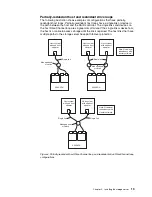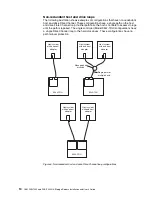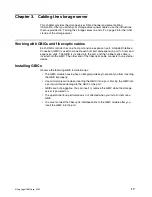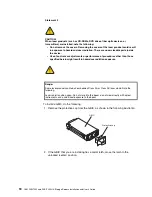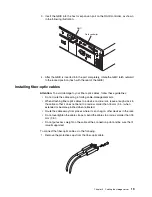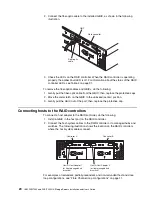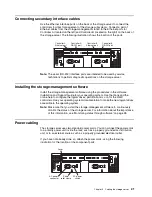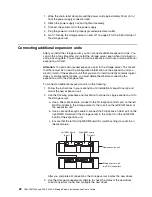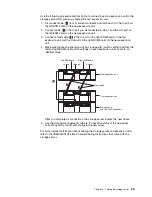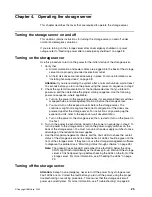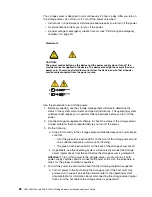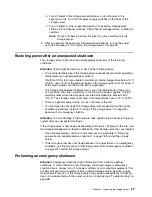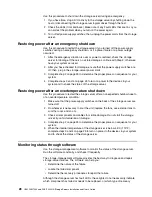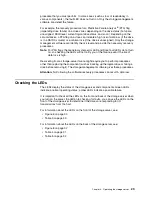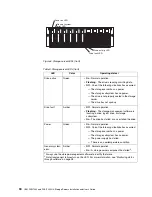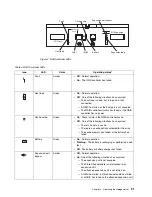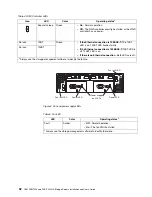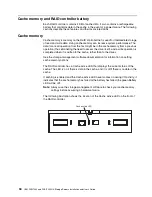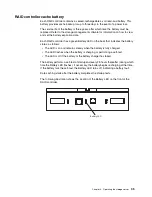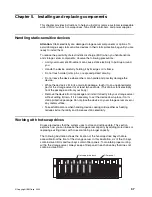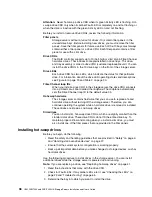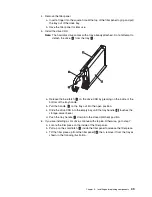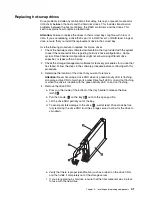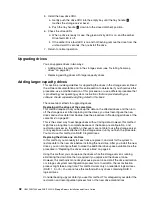
Chapter 4. Operating the storage server
27
b. Turn off power to the storage server before you turn off power to the
expansion units. Turn off both power supply switches on the back of the
storage server.
c. Turn off power to other supporting devices (for example, management
stations, Fibre Channel switches, Fibre Channel managed hubs, or Ethernet
switches.
Note:
You do not need to perform this step if you are servicing only the
storage server.
5. After you perform the necessary maintenance procedures, turn on the power
using the procedure in “Turning on the storage server” on page 25.
Restoring power after an unexpected shutdown
The storage server might shut down unexpectedly under any of the following
conditions.
Attention:
There might be data loss in each of the following cases.
• The internal temperature of the storage server exceeds the maximum operating
temperature (an overtemperature condition).
If both fan CRUs fail or are unable to maintain an internal temperature below 70
°
C
(158
°
F), one or both of the power supplies in the storage server will shut down. If
both power supplies shut down, the unit is inoperable.
The storage-management software warns you if the temperature of the unit is
rising, before it has risen sufficiently to shut down the power supplies. The first
warning comes when the storage server internal temperature exceeds 45
°
C
(113
°
F). The storage server shuts down if the temperature rises to 70
°
C (158
°
F).
• There is a general power failure or a loss of power to the unit.
• You are forced to shut down the storage server without performing the normal
shutdown procedures (listed in “Turning off the storage server” on page 25)
because of an emergency situation.
Attention:
To avoid damage to the hardware, take special care when restarting your
system after an unexpected shutdown.
If the storage server shuts down unexpectedly, but there is still power to the site, use
the storage-management software to determine if the storage server has overheated.
• If an overtemperature condition is indicated, use the procedure in “Restoring
power after an overtemperature shutdown” on page 28 to restart the storage
server.
• If the storage server has shut down because of a power failure or an emergency
shutdown, use the procedure in “Restoring power after an emergency shutdown”
on page 28 to restart the storage server.
Performing an emergency shutdown
Attention:
Emergency situations might include fire, flood, extreme weather
conditions, or other hazardous circumstances. If a power outage or emergency
situation occurs, always turn off all power switches on all computing equipment. This
will help safeguard your equipment from potential damage due to electrical surges
when power is restored. If the storage server loses power unexpectedly, it might be
due to a hardware failure in the power system or midplane (see “Troubleshooting” on
page 65).
Summary of Contents for FAStT200 HA
Page 1: ...IBM IBM FAStT200 and FAStT200 HA Storage Servers Installation and User s Guide SC21 P877 50...
Page 2: ......
Page 3: ...IBM IBM FAStT200 and FAStT200 HA Storage Servers Installation and User s Guide SC21 P877 50...
Page 10: ...viii IBM FAStT200 and FAStT200 HA Storage Servers Installation and User s Guide...
Page 26: ...8 IBM FAStT200 and FAStT200 HA Storage Servers Installation and User s Guide...
Page 34: ...16 IBM FAStT200 and FAStT200 HA Storage Servers Installation and User s Guide...
Page 42: ...24 IBM FAStT200 and FAStT200 HA Storage Servers Installation and User s Guide...
Page 54: ...36 IBM FAStT200 and FAStT200 HA Storage Servers Installation and User s Guide...
Page 88: ...70 IBM FAStT200 and FAStT200 HA Storage Servers Installation and User s Guide...
Page 94: ...76 IBM FAStT200 and FAStT200 HA Storage Servers Installation and User s Guide...
Page 112: ...94 IBM FAStT200 and FAStT200 HA Storage Servers Installation and User s Guide...
Page 113: ......

